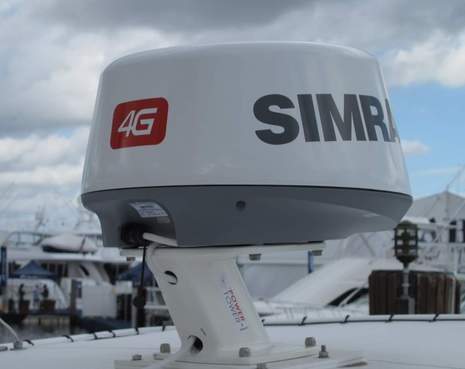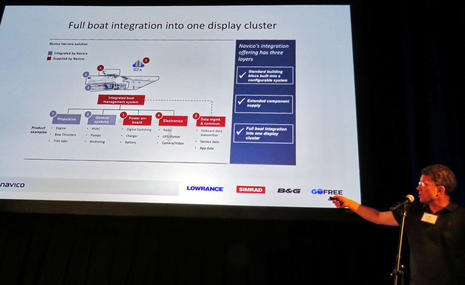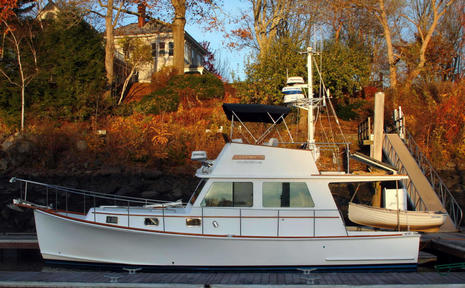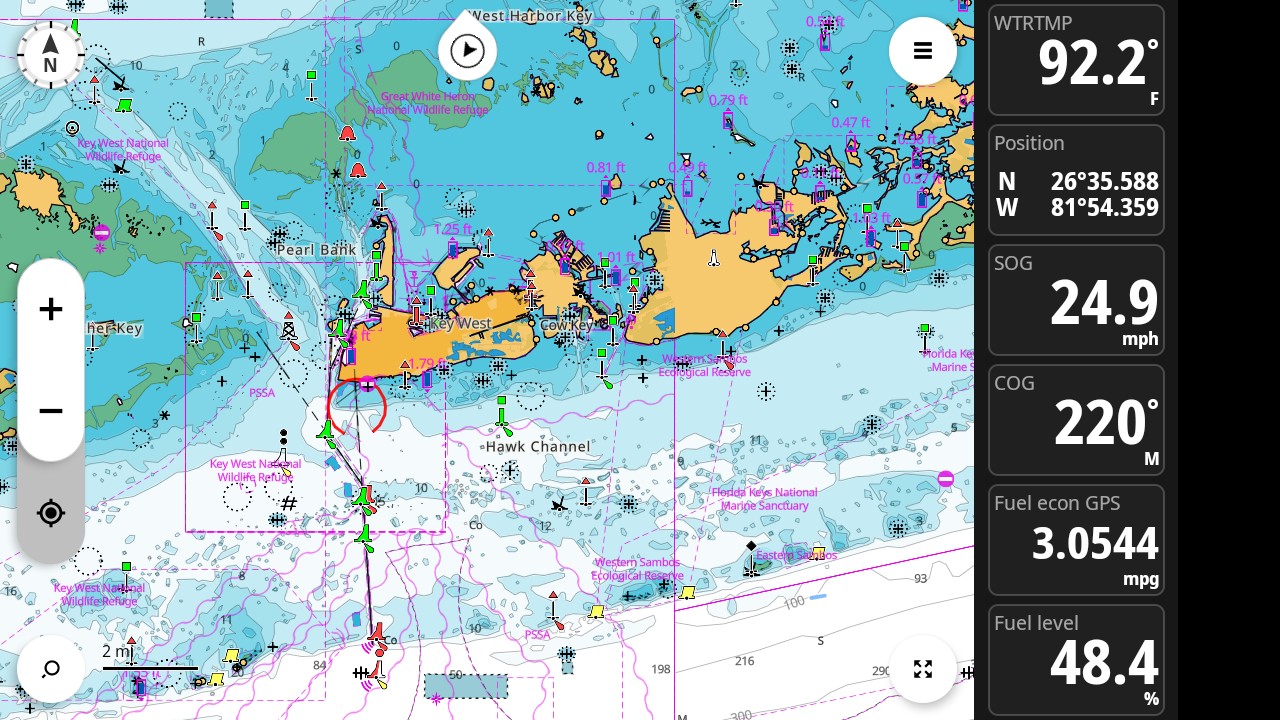Navico Broadband Radar 4G, the launch demo
Holy cow! The just-announced-today Lowrance/Simrad 4G Broadband Radar may look just like the original BR24 and its 3G upgrade, but there’s some stonishing NEW technology under that dome. In fact, Navico engineers seem to have overcome what I thought was an immutable law of radar physics, that beam width is purely a function of radar antenna length. I understood how the original FMCW solid state transmit technology — which is something like CHIRP sonar — could produce better range resolution, but the BR24 and 3G are still limited to a 5 degree horizontal resolution just like all the other radomes in that 20″ size range. Not 4G!…
Navico calls the new feature “Beam Sharpening” and while I have no idea how they do it, yesterday morning they demonstrated it pretty convincingly. Actually, they took us to a spot in Fort Lauderdale where I had photographed the crisp target separation seen by what was a new Raymarine 4-foot open array HD radar back in 2007. Check that image versus the left hand window below, in which the new 4G’s “Target Separation” control has been turned to High. The right window shows an unsharpened 4G beam width while the left is purportedly equivalent to the 2.6 degree beam width normally associated with four foot antennas. When I wondered if the 4G could separate two small targets that were within the normal 5 degree beam and at the same range, the highly enthusiastic chief engineer Don Korte — “this is the best radar I’ve ever been involved with” — whipped out some screen shots and a photograph that showed a tight flock of kayaks resolved. You can see the same imagery yourself on page 15 of Navico’s new Essential Guide to Broadband Radar, which should be online later today…
And, yes, that is 4G doing independent dual ranges on the Simrad NOS screen above, though both windows are set to the same range. I’ve learned to appreciate dual range displays on other radars but have often been frustrated with certain limitations. What a nice surprise then when I asked Korte if it could do chart overlay using even one of the ranges, and he showed us how 4G can not only overlay both ranges but put those in separate windows with pure radar alongside. Wow. But do note that this feature, and a few others, only work on certain processors like the Simrad NSO and NSE (not the NSS). Each range will also support 10 MARPA targets for a total of 20…
There’s lots more to say about 4G, including a claimed 100% range improvement over the original BR24, but I’ll close with this shot of Don Korte pointing out the teensy “magnetrons” on the 4G printed circuit board. 4G is still very much an instant-on, super low emmission solid state radar. It’s just that now we’re learning that that can mean more than we thought.
So it turns out that Raymarine and Navico are not the only ones who like to test their radars around the Ft. Lauderdale submarine pen. This is purportedly a screen shot of a Furuno DRS4D running at 15 knots. Note how well this 24″ antenna resolves its intrinsic 4 degree beam width. Note too how it is imaging some of the vessel’s wake, which suggests a minimal area obscured by magnetron main bang:


















O. M. G. I may be dining on some of my own timeless verse.
Please Garmin, give me some hope you have something coming along in this neighborhood!
I don’t know about Garmin, Sandy, though that company is capable of most anything. But on the FLIR/Raymarine cruise last night there was talk about how FLIR had purchased a company called ICx last year. ICx purportedly has solid state radar technology:
http://investors.flir.com/releasedetail.cfm?ReleaseID=514347
All that is nice and neat, and I already was convinced chirping radars were the most interesting deal for navigation.
Good to know I’ll probably equip my next boat with a 4G, and benefit from its enhanced resolution.
Still, looking at the brochure, it seems birds detection for us fishermen is not yet even half acceptable. 500feet extreme (thus beyond reasonable hope) maximum (the same as for the 3G), ie not even 0.1nm? Really? They really felt the need to communicate about that? Birds are easy to spot up to 1nm with bare naked eyes… Darnit: even in the fog, at a distance of 500feet, you don’t even need to see them: you hear them alright already.
Which brings me to the most important question in my eyes: is the 4G still not to be run at the same time as a conventional open array (I’m thinking about Simrad’s 6kW or even 10kW, depending on the space I’ll have), or not? For, really, with such pathetic abilities regarding birds spotting a few nautical miles away (let us say, 3nm, so to get to them in 5min at a fairly conservative 30kn), I sure won’t be able to do without an open-array… which I’d like to turn on only for fishing, while leaving the chirping radar always on for navigation purposes.
So, what about that? A few monthes ago, there had been rumors as to an upcoming ability to run simultaneously a 3G and some HD Navico radars together without interferences, possibly through a firmware upgrade or such. Not having yet invested in new electronics (nor new boat, for what matters), and not going to for a few monthes more, I wouldn’t care much if I’d instead need a 4G for that… but if still impossible, this is going to be some kind of a bummer…
Just when I thought radar could not get any better. I imagine there will be some upset customers who recently purchased the 3G.I was glad to hear about the increased range capability along with adding dual range mode.The beam sharpening is what really caught my attention.My jaw dropped when looking at some of the images on the Simrad website. Navico seems to be investing alot of money in R&D further seperating themselves from the competition.
Any sense of availability and cost?
Roy
I was all set to get the Raymarine E7, but now with this new longer range 4G, I’ll be back looking at Lowrance HDS systems.
Any idea why Raymarine’s HD radar price is so much higher than Lowrance or Garmin’s? Maybe I’ll just hold off to spring and hope Raymarine comes out with something in the broadband… and makes it affordable!
I was at IBEX last week and found it interesting that “the others guys” dismissed broadband just like they did last year. Heck, with Navimo having nothing new to announce, why wouldn’t they slam Broadband? How did Navico miss opportunity to launch/announce during IBEX and possibly earn a coveted IBEX 2011 award? They must be rolling in the $$ to seemingly not care about such opportunities!
What’s the expected retail pricing & availability of the 4G radar?
Did anyone every hear what the deal was with interfacing the Broadband Radar directly with a PC using Expedition? Can’t find any real details on if this is possible without a Simrad/B&G/Lowrance MFD in the system first. With the added range and nice low power consumption this is starting to be a no-brainer for replacement of the small dome on the mast, leaving our big open array for when you want to a pulse radar (rain squalls, long distance, etc). The cost of an MFD (not to mention where on earth we put it) would make that less likely to happen.
Welcome to 2 months ago Ben 🙂
http://vimeo.com/28156996
There was a hint of this one of your links, I believe it was one of the trade show awards or certification links, it referenced “Simrad 4G” but did not provide any details, initially I actually thought it was a typo!
I did try the 4G radar in Sweden a few weeks ago and was told by the dealer that the pricing will be similar to the 3G radar, and perhaps a few bucks chaeper.
I was also told by the Navico dealer that 95% of the radars they sell in Sweden is the broadband version. Just like Jeff A I´m wondering why the competitors haven`t released their own broadband radars.
Is there any word if Simrad will start offering true motion wakes? That seems to be the advantage that Furuno still has in this market.
Steve, I think Furuno still has the only small radars with ARPA, not just MARPA, and there may be other unique features. The UHDs are amazing.
“Available in November 2011 from authorized dealers and distributors throughout the United States and Canada, the new Lowrance Broadband 4G Radar has a minimum advertised price of US $1,899, while the Simrad and B&G Broadband 4G Radars have a suggested retail price of US $2,299.”
Note the Lowrance model comes with a different cable than the others, and maybe no interface box.
Don Korte was also proud that 4G is literally in production when announced.
I am intrigued by broadband radar. I recently bought a Furuno radar and I am quite happy with the unit. I started out looking at broadband radars, but dropped the search when I discovered the cost of the broadband radars did not include the display. Multi-function displays are expensive. I might reconsider if they were to use an iPad or laptop computer for the display.
As it is now broadband radar is not cost effective for me as much of my electronics is Raymarine that came with my boat when I purchased it
We’ve been very happy with the BR24/NSE8 system we installed on Majaca in the Spring of 2010. But a bit of ‘buyer’s remorse’ is setting in after seeing what the 4G can do. I don’t suppose anyone caught any hint that Simrad might offer an upgrade path short of scrapping the ‘old’ BR24???
I wonder if the 4G system is really a breakthrough in radar beam technology or just clever processing of the radar image. Once the radar image is in fundamental digital form, like CDs, iPods, etc in the audio world, signal processing becomes possible.
Consider the image with the row of pilings in the 4G image that looks like piers in the non 4G image. Is it possible that the original image for both showed a kind of dumbell shape and the 4G software turned that into a discrete blob, by assuming it was a pile.
I guess it really doesn’t matter what technology is used to get the better images- they sure appear to be better.
Hello Gram,
Nick here from Exp.
Yes, Exp can use the BR24/3G/4G radars. I’m very impressed with the image quality, especially under 10km ranges.
A couple of the Volvo Ocean race boats are using Broadband radars too.
I’ve been spending quite a lot of time with the Broadband radars recently (Navico turns out to be very good to work with) and the interface to the 4G beam sharpening will be hopefully be available in a near Exp update. There are some items that can still be implemented, such as MARPA, when someone requests them.
Navico has an adaptor cable to connect an ethernet cable to the RI10 or RI11 interface.
Obviously, Navico charges a per radar licence for this ability. Unfortunately I mostly make a small loss on that, but the functionality is a nice addition to Exp.
Cheers,
Nick
Thanks, Nick!
Rose Point also built support for integrating Broadband Radar with its Coastal Explorer software, but then decided not to offer it because of the large license fee: http://goo.gl/nd4uF
I had hoped that Navico would forego the license fee for PC Broadband integration if the user also had a Navico MFD on the network, and Navico management had even said that they were agreeable to this concept. But now they say they haven’t had the resources to make it happen.
Navico has a new video on 4G and the other Broadband Radars here:
http://www.youtube.com/watch?v=niWTM2MullU
It’s interesting but I must say that I object to the notion that since “100% of all collisions” occur when the target is within 80 feet of your vessel therefore magnetron radars with a main bang obstruction of targets within 80 feet are unsafe. It sounds logical at first, but it’s not. I would say that 99.9% of all successful collision avoidance happens when the target vessel is more than 80 feet away.
Doug – I’m having a bout of “buyer’s remorse” as well. I installed a BR-24 and NSE12 in June to take advantage of the rebates, only to discover that the 3G started shipping shortly thereafter. Now comes the 4G. An upgrade program would be great.
Ben-
FLIR – ICx indded has been in radar for some time – especially FMCW radar. This link gives great information about their perspective about FMCW Vs Pulse Doppler.
http://gs.flir.com/surveillance/surveillance-land/radar-systems/radar-technology/frequency-modulated-continuous-wave-radars/
Note that standard marine radars are NOT capable of Doppler processing as they are not coherent. But they ignore the potential for Frequency Modulation (FM) to be used in PULSE mode to achieve “pulse compression”. Pulse compression technology is the next step beyond FMCW.
How do these images compare to those shown 11/2008?
Nick wrote: “A couple of the Volvo Ocean race boats are using Broadband radars too”
For the record 4 of the 6 Volvo Ocean Race boats are running Broadband Radar (BR24 and 3G versions), some using Nick’s software, others running standard multifunction display units.
Alan
p.s. 4G genuinely amazes even me.
Nick wrote: “A couple of the Volvo Ocean race boats are using Broadband radars too”
For the record 4 of the 6 Volvo Ocean Race boats are running Broadband Radar (BR24 and 3G versions), some using Nick’s software, others running standard multifunction display units.
Alan
p.s. 4G genuinely amazes even me.
The 4G radar is Not compatible with the NSS???
What’s with that?
Bill, 4G radar is quite compatible with the NSS — in fact, that’s an NSS12 showing 4G in the last photo above — but apparently the NSS does not have enough horsepower to do dual range or beam sharpening. It’s all pretty well explained on SimradYachting.com now:
http://goo.gl/iID9v
The, just out, December issue of Practical Boat Owner has an on on-the-water test of the 4G radar. The verdict is that it is better than the 3G, but they are a bit mystified as to why, since the specs on paper are very similar. They really like the “beam sharpening” feature, which seems to work so well that it should be left on all of the time.
Correction: NSS DOES use the 4G’s beam sharpening feature. What the Simrad Yachting feature graph is trying to say is that the NSS (and Lowrance HDS) can’t CONTROL the amount of beam sharpening. On the NSS and HDS it’s always set to High (maximum beam sharpening) but on the NSE and NSO you can reduce it from high to medium or low. I think that the only reason to reduce beam sharpening is to take the jiggles out of a shore line. You can see the difference in the topmost screen shot.
Steve, I’m not sure what “specs” PBO is referencing but Navico says that 4G is a major hardware upgrade.
Is anyone aware of a system or hybrid arrangement that achieves both:
* ARPA capabilities– true auto-identification of targets, i.e. with no operator needed in order to use cursor and manually identify them; subsequent target tracking; and output of target info via NMEA (i.e. as TTM)
AND
* Broadband capabilities– sharpening and good imaging at short range; low power demand
??
I need a system that is ARPA, and am considering the Furuno MDF8 + DRP2d, which is a pretty good match for my needs. But my application is entirely at short ranges, and low power demand would be advantageous, so Broadband seems attractive.
However, as I understand it, none of the Broadband processors can do ARPA. Maybe there is PC software that would enable me to do ARPA with a Broadband?
Or some other way to merge the nice Furuno ARPA with the nice Broadband capabilities?